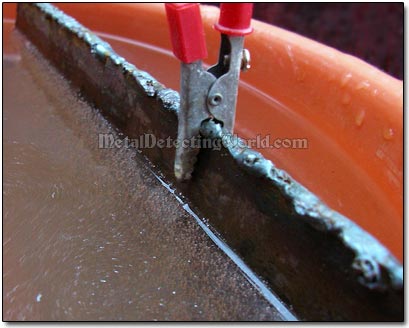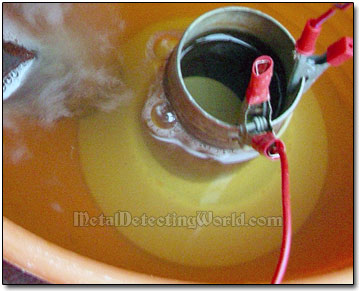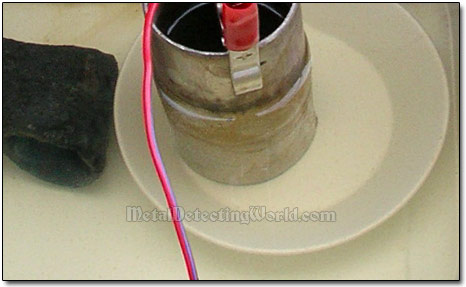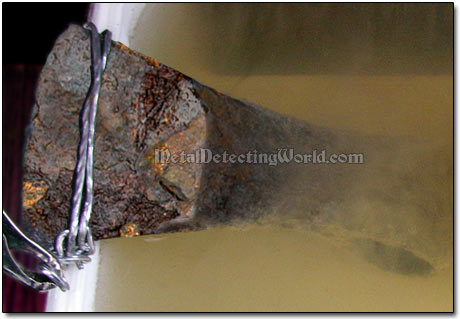Electrolytic Rust Removal - A Detailed Illustrated Tutorial, page 19
3. Assembly of Electrolytic Setup: How To Place Electrodes in Electrolyte Properly
Proper placement of electrodes into electrolyte is critical for the process. To make sure the electrodes are set up correctly, follow these instructions:
• ANODES (positive electrodes, "waste" electrodes) should protrude out of the electrolyte a little so the power clamp (clip) could be attached to it.
Anode Sticks Out of Electrolytic Solution

• The positive power clamp CANNOT be immersed into the electrolyte because it will quickly disintegrate!
• The anodes MUST NOT touch the iron object being derusted, or short-circuiting will occur. Various non-conductive items such as plastic bottle cups and lids, pieces of rubber hose and plastic window screen, glass ashtrays and ceramic saucers serving as stands, can be used for sufficient separation.
• The anodes must be firmly set (maybe with use of clamps or other means to hold them in place) inside the container so that they cannot move freely, shift onto the iron object(s) being derusted or fall over them, and eventually touch the accumulated sludge on the container's bottom.
 To avoid the latter, you can place the anode(s) onto a non-conductive stand that would keep the anode(s) one inch above the bottom. Or you can place the IRON OBJECT being derusted on the stand instead (see details in the "Placing Artefacts in Electrolyte Properly" section on page 21).
To avoid the latter, you can place the anode(s) onto a non-conductive stand that would keep the anode(s) one inch above the bottom. Or you can place the IRON OBJECT being derusted on the stand instead (see details in the "Placing Artefacts in Electrolyte Properly" section on page 21).
Anode Is Placed on Inverted Saucer

Or place the anode inside the saucer.
Anode Is Placed inside Saucer

 You can cut down on the electrolysis time by placing the anodes as close to the iron object as possible. Just make sure the iron object does not move and come in contact with the anode(s) during the process. This might happen after the rust is removed from underneath the object.
You can cut down on the electrolysis time by placing the anodes as close to the iron object as possible. Just make sure the iron object does not move and come in contact with the anode(s) during the process. This might happen after the rust is removed from underneath the object.
 If the surfaces of the object you are treating are not equally rusted, place the anodes further away from the areas that are cleaner than others. Otherwise, the cleanest portions of the object will waste electricity splitting water until the rusted portions receiving the least amount of current are cleaned.
If the surfaces of the object you are treating are not equally rusted, place the anodes further away from the areas that are cleaner than others. Otherwise, the cleanest portions of the object will waste electricity splitting water until the rusted portions receiving the least amount of current are cleaned.
NOTE: If you use a metal container, make sure the anodes are separated from it by insulators. A plastic window screen best serves the purpose as it allows the current to flow right through it.
• CATHODE (negative electrode) can be either just the charger's power clip attached to the iron object being derusted or additional connecting sets, or a piece of wire such as steel wire wound around the object.
Cathode Wire is Wrapped Around Axe's Blade

Some sources state that cathode connector can be submerged since the electrical supply is preventing it from rusting; however, I would recommend to keep the cathode out of the electrolytic solution. At one time, I immersed the cathode into the electrolyte along with the rusted artifact, the cathode provided reaction but the rusty relic did not (no bubbling).
It seemed that the current was taking the least-resistant electrical path - through the immersed cathode, but not through the rusty relic, or just partially, so the relic was receiving the least amount of current. Most energy was wasted for splitting water at the cathode until the iron object slowly got de-rusted enough to receive an adequate amount of current.
Since then I have kept the cathode out of the electrolyte unless I saw a satisfactory reaction going at the rusty object. Another reason I do not immerse the cathode in electrolyte is that I do not want the cathodes to be contaminated with toxic hexavalent chromium that appears in the electrolyte when the stainless steel anodes are used.
Immersing the Cathode Was Not Productive
